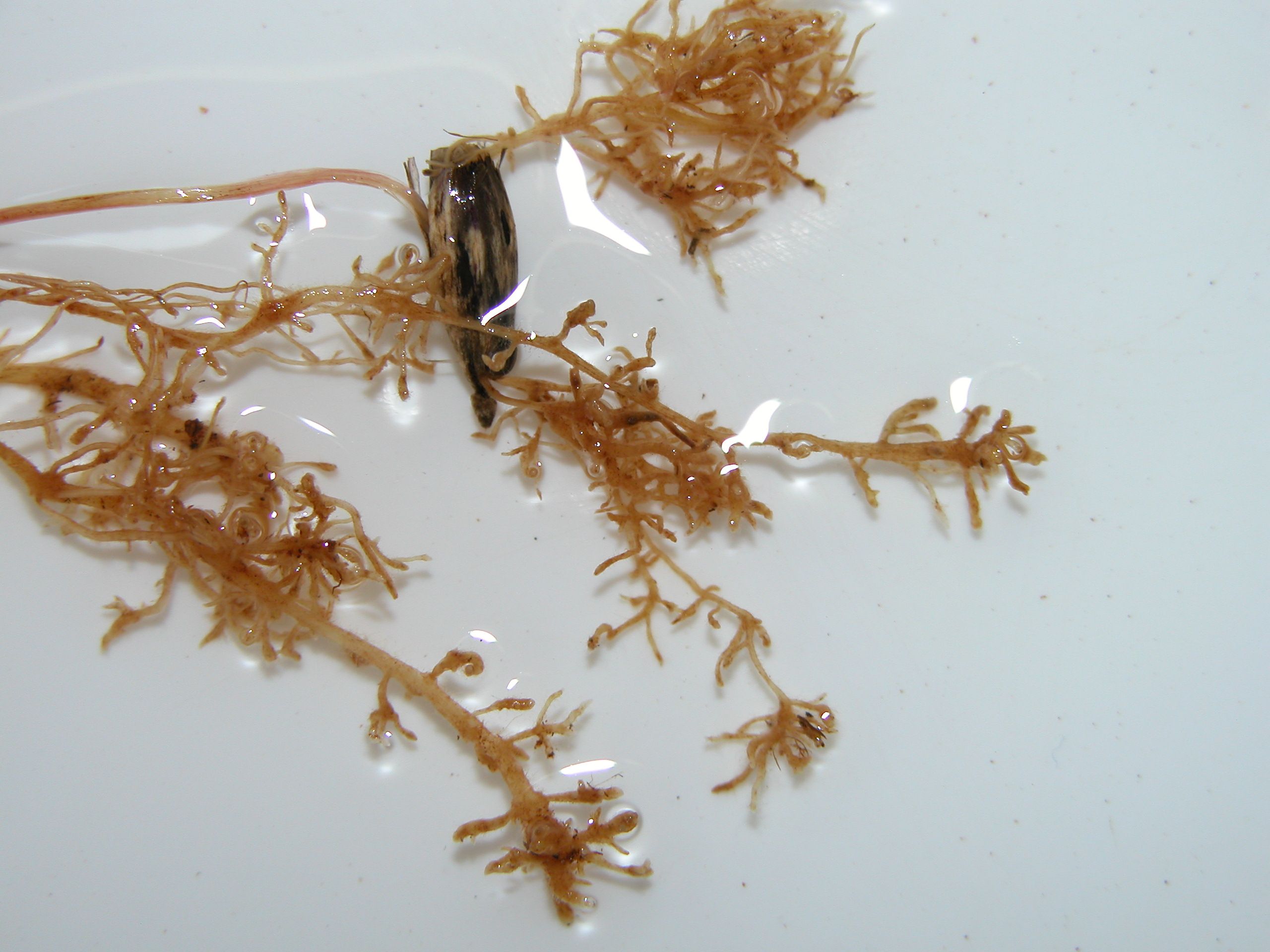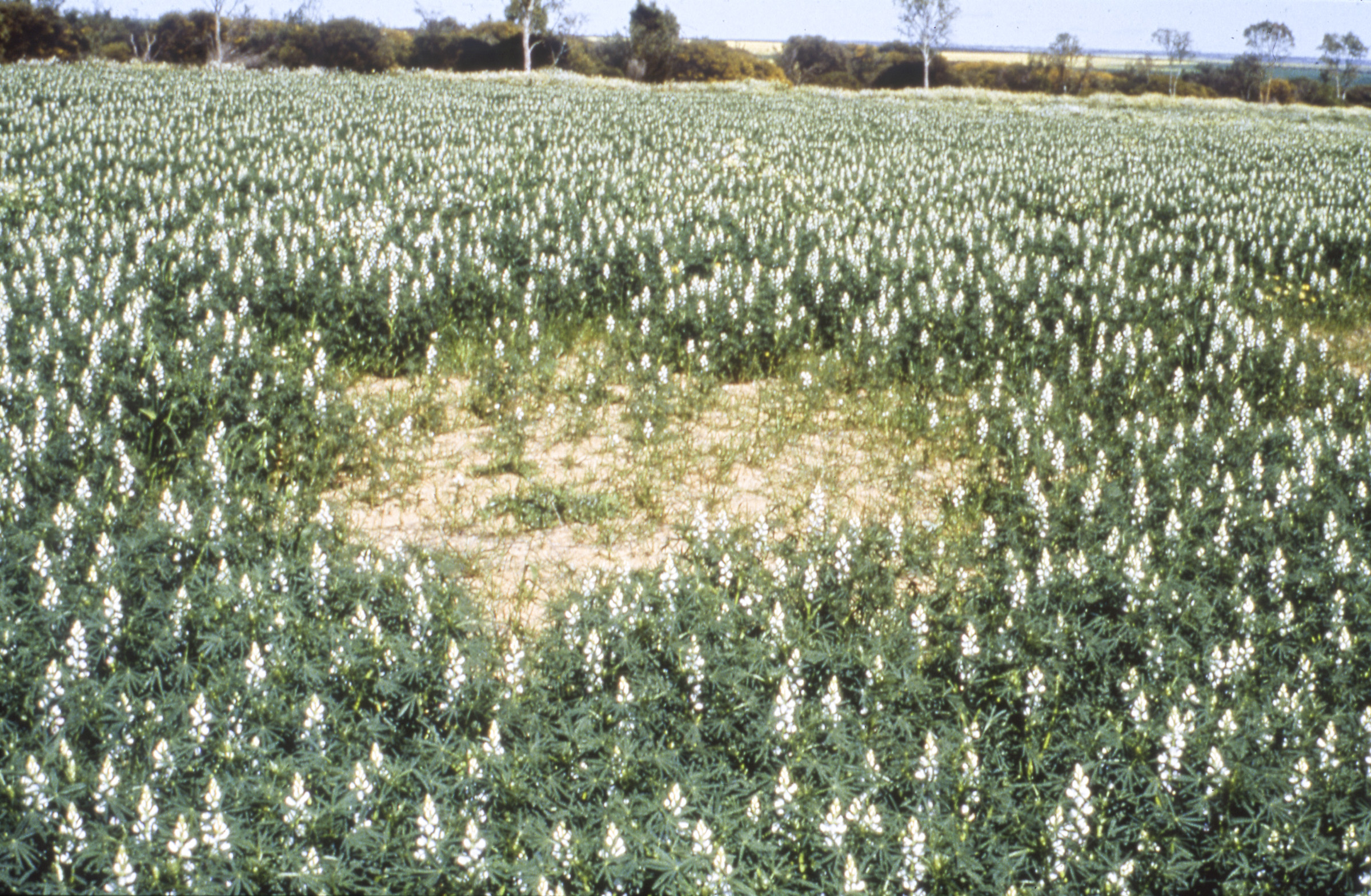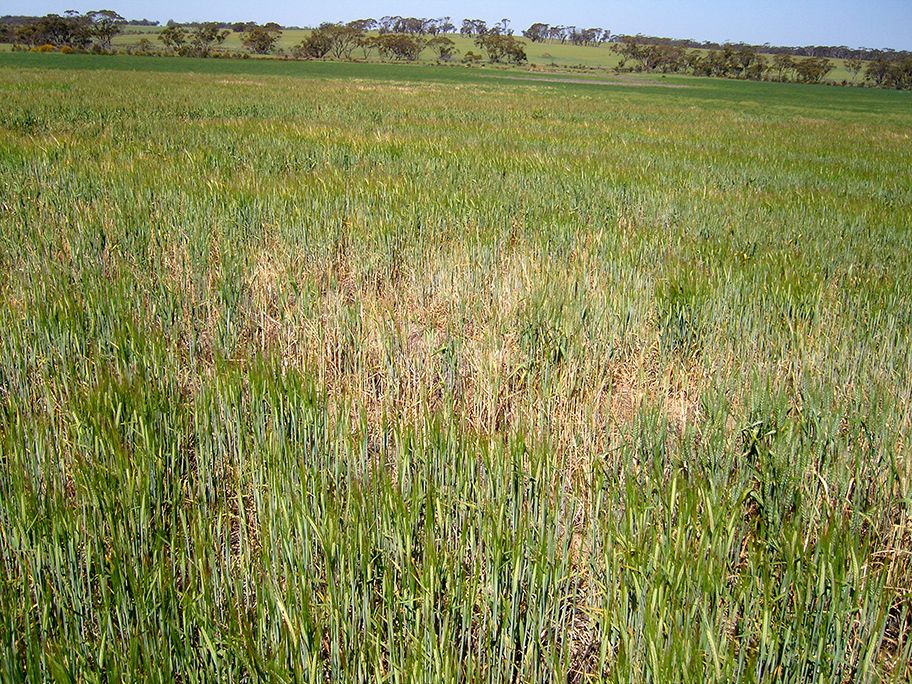What are soil pests and diseases?
Organisms that attack living plant tissue and cause plant diseases are commonly known as pathogens.
Soil-borne diseases and nematode pests directly influence a plant root’s capacity to acquire water and nutrients by compromising root function. An impaired root system is unable to fully utilise the available water and nutrients in the soil profile; and diseased plants provide less extensive below- and above-ground carbon inputs to feed soil biota. Low water-use efficiency of diseased plants associated with impaired root growth and function is one reason for increased drainage under dryland crops.
These undesirable soil organisms include a range of insects, parasitic nematodes, protozoa, viruses, bacteria and fungi. For a disease to develop there must be a host plant, a pathogen and an environment suited to its growth.
Pathogens negatively affect or inhibit plant growth and are usually a normal component of the soil population – naturally existing in relatively low numbers. Pathogens can exist in the soil for long periods of time without causing an outbreak of disease in plants. Growth and survival of pathogens is dependent on soil conditions (such as soil pH, water content, oxygen level, nutrient level, or presence of other soil organisms) and are different for each species of pathogen.
-
For a disease to develop there must be a susceptible host plant, a pathogen, an infection mechanism and an environment suited to the pathogen’s growth or survival.
-
Pathogens affect biological fertility directly by altering the capacity of a plant to acquire water and nutrients; and indirectly through a reduction in the plant biomass returned to soil.
-
Soils with low biological activity under warm, moist conditions can favour the rapid growth of plant pathogens, as there are few antagonists to compete with or suppress them.
-
Pathogenic organisms are a normal part of the soil but generally exist in low numbers.
-
In natural and managed environments a complex food web exists. ‘Predator-prey’ relationships and competition for limited resources (energy and nutrient sources) help control the balance of species present in the soil.
-
When these relationships have evolved and a reduced incidence of disease occurs, such soils are termed ‘suppressive’.
-
Some soils are able to develop properties that support natural disease suppression.
-
All soils have a natural level of disease suppressive activities. In most soils long term management can either reduce or increase this level of suppression.
Individual soil-borne diseases and nematode pests are explained in the following pages. Their listed order is based on economic importance associated with production loss of crops and pastures in Western Australia.
The disease triangle
There are three main components that result in the development of soilborne diseases, including a virulent pathogen or nematode pest, a susceptible plant host, and a disease-favourable environment. These three components are often shown as a disease triangle. Importantly, if both a virulent pathogen and a susceptible plant host are present, disease outbreaks will only occur if the environment is favourable to the pathogen/nematode or detrimental to plant growth. Understanding potential interactions in a disease triangle aids a grower or consultant to develop management strategies to minimise disease. The basics to manage disease using the disease triangle concept is to:
- Exclude or reduce the inoculum of the pathogen or nematode pest.
- Increase the plant host resistance to a disease or nematode pest.
- Modify the environment so it is unfavourable to disease development or nematode lifecycle.
It is important to make the distinction between the presence of a potential pathogen or nematode pest (often referred to as a sign of the pathogen) with the disease that can occur on a plant. Disease refers to the symptoms on the plant that are caused by a pathogen or nematode pest. This should not be confused with the presence of a potential pathogen on the plant. For example, pink hyphae growing on wheat and barley crowns from the fungus that causes fusarium crown rot is a sign, not a symptom, of the potential pathogen, but the honey-brown discolouration at the crown of plant stems and whiteheads are symptoms of disease.

How do soil pests and diseases affect plant growth?
Some pathogenic species will usually only cause disease in one species of plant. There are some cases where others can cause disease on or in plants that are not closely related.
Root disease or suppression of root growth
Root disease can be a major restriction to plant production for both crops and pastures. Root disease often reflects an imbalance in the soil biota food web, coinciding with environmental conditions suited to the growth of the pathogenic population, enabling it to become dominant.
Biota invading growing roots to access food can restrict root growth and performance, reducing the exploration capacity of roots to source nutrients and water – decreasing plant production. The degree of root damage will generally relate to the number and type of disease pathogens present. Soil organisms Rhizoctonia solani and take-all are both fungal root diseases that consume plant tissues, prevent the growth of the root tip, block water transmission and cause necrosis of tissues.
Plant disease expression
Plants may show signs of disease that can be observed visually, such as discolouration, necrotic lesions, or the formation of root galls.
Early plant senescence
Crop and pasture plants may die sooner than expected in the given season. This can occur in distinct patches within a paddock, or be more widespread.

What factors influence the presence of soil pests and diseases?
Pathogens can exist in the soil for long periods of time without causing an outbreak of disease in plants. Disease outbreaks can be caused by an increase in the population of the pathogen, or by an increase in susceptibility of the plant.
Crop rotation
Rotations including a susceptible host plant build up inoculum and increase the risk of disease. In managed systems such as agriculture and horticulture, monocultures increase the chance of a disease outbreak occurring with a ready supply of a genetically similar food source, supporting the population growth of specific organisms. Irrigated systems also provide a constant supply of water which can enable spores to germinate and cause disease in host plants. Conversely, break crops (crops that are not attacked by, or are highly resistant to, the pathogens present) can be used in a rotation to reduce inoculum level.
Crop nutrition
Crop nutrition can increase the severity of disease, but also the ability of a crop to ‘grow through’ high disease pressure and reduce the potential impact of pathogens. High ammonium-nitrogen levels are associated with a reduction in take-all disease, whilst increasing nitrate-nitrogen levels result in increased expression of take-all disease.
Herbicides
Herbicides can increase disease severity but can also be used to reduce the population of susceptible weed or volunteer species during a break crop cycle.
Irrigation
Irrigated systems provide a constant supply of water, enabling germination of spores which can cause disease in host plants, but may also enable plants to grow rapidly and yield despite some disease attack.
Soil conditions
Soil disturbance generally stimulates nematode activity. Whilst bacteria are not affected by cultivation, fungi produce hyphae (very fine threads) that are destroyed by soil disturbance. The retention of infested residues at the soil surface increases the potential damage to young seedlings from stubble-borne diseases.
Conditions favourable for the growth and survival of pathogens are different for each species of pathogen but are related to soil pH, moisture content, oxygen level, nutrient level and the activities of other soil organisms.
Predator-prey relationships
The soil food web is a way of relating the very complex predator-prey relationships that exist between soil organisms. Bacteria, fungi and root feeders (i.e. pathogenic nematodes) decompose organic matter, and are in turn consumed by beneficial nematodes, protozoa, earthworms, collembola and micro-arthropods. These in turn may be consumed by mites, beetles and ants.
A large soil population consisting of many different organisms ensures competition for food resources and a healthy predator-prey relationship in which no one organism dominates. Soil organisms can achieve this in a number of ways including preventing the establishment of soil pathogens on plant surfaces, competing for food, preying (or feeding) on pathogens, or through chemical inhibition.
Agronomic influences can also disturb the predator-prey relationship in soil by decreasing the diversity of food types and changing the physical environment.
A healthy soil environment does not mean that disease-causing organisms are not present in the soil – merely that symptomatic expression or impact is limited (thus the soil is termed suppressive). This can result in the disease potentially being prevented or maintained at a lower, less damaging level.

Features of soil with pests and diseases
Unbalanced soil nutrition
Soil pests and disease organisms can impact the nutrient balance of the soil. Declining soil nutrition can cause constraints to soil functions critical to plant growth. Bacteria involved in denitrification produce nitrous oxide under anaerobic conditions – a greenhouse gas that also represents loss of a valuable nutrient.
Low biodiversity
Soil with low biodiversity, may be more impacted by soil pests and diseases. Disturbance or imbalance in the soil food web can influence the functioning of soil including nutrient availability. A high presence of undesirable organisms can out-compete beneficial organisms for food substrate. Fungi and bacteria decompose plant residues differently and influence nutrient cycling.
Low soil organic matter
Declining levels of organic matter in the soil can interact with physical or chemical constraints to limit soil biological function. Two primary factors constraining biological activity are moisture availability and carbon.
Poor soil structure
Soil pests and disease are impacted by aspects of soil structure including porosity, drainage and aeration that are the foundation for maintaining soil biota and their soil environment.

Managing soil pests and diseases
For a disease to develop there must be a host plant, a pathogen and an environment suited to its growth. Since these factors interact, it is important to consider each one and incorporate a variety of management approaches.
Non-host crops may be utilised to reduce inoculum build-up. Rotational sequences of different crops allow time for a decline in pathogen numbers and various planting, tillage and seeding practices can be changed to alter the environment. Additionally, managing non-pathogens in the environment is beneficial – the larger and more diverse the microbial community in the soil, the less likely single pathogens are able to dominate and become major disease problems. This natural competition and self-regulating capacity of the soil community is an important component of sustainable land use, and is strongly dependent on high soil organic matter levels.
Crop rotation
- Successive wheat crops can suffer yield declines up to 15% due to growth of pathogenic and inhibitory organisms on their roots (particularly under no-till).
- Rotations that include a break crop such as grain legume or canola greatly reduce root diseases in cereals such as take-all and cereal cyst nematode (CCN) because these crops do not host the cereal diseases. However, beneficial plant-specific organism numbers will also decline and may slow the development of ‘suppressive’ characteristics.
- Canola has a second beneficial effect, the release of chemicals into the soil which kill disease causing fungi and other soil organisms. This process is known as ‘biofumigation’.
Choose tolerant crops and varieties
Some crop types and varieties are able to modify the localised soil environment (and thus the organisms in the rhizosphere) through the growth of roots and release of root exudates. Crop types and varieties with early vigour have more rapid root growth and are better able to ‘grow through’ or resist disease pressure.
Organic matter
Soils with high levels of organic matter and biological activity, or those sheltering a specific group of antagonistic microorganisms seem to prevent more aggressive pathogens from taking hold.
Presence of beneficial soil organisms
- The presence of Trichoderma can result in greater lateral root length and decrease the impact of take-all on wheat roots. Soils with high levels of mycophagous (fungal-feeding) amoebae have been associated with disease suppression of Verticillium wilt, take-all and Rhizoctonia.
- Inoculation and survival of microorganisms that remain within the bulk soil is difficult. Predation, scarcity of suitable food substrates and competition with endemic species, and the harsh environs generally result in rapid death of the introduced organisms. The exceptions to this are those organisms that survive within plant structures (i.e. endophytes, rhizobia).
Healthy roots
In order to cause disease in plants, fungal and bacterial pathogens in soil must enter the plant roots. Both the health of the root system and the rate at which roots are growing through the soil are likely to influence the ability of a pathogen to infect/enter roots. Restricting root development (through compaction, subsoil acidity, poor nutrition) can increase the impact of soil-borne plant pathogens.
Fertiliser management
- Soil nutrient imbalances can influence disease susceptibility in crops – healthy crops are less susceptible to damage and symptomatic expression indicating the presence of disease is less likely.
- Too much nitrogen can result in lush growth, creating an ideal environment for leaf pathogens or the vectors of viral diseases.
- Acid soils are generally less suited to the growth of plant pathogens. Where soil pH increases, activity of root-infecting pathogens may also increase.
- Nutrient deficiencies can predispose plants to a higher level of disease infection, further limiting plant growth.

PAGE REFERENCES AND ACKNOWLEDGEMENTS
Material on this page adapted from:
- Hoyle FC (2007). Soil Health Knowledge Bank.
- Murphy D, Hoyle FC, Collins S, Huberli D and Gleeson D (2021). Soil Quality: 5 Soil Biology. SoilsWest, Perth, Western Australia. [Access]
Last updated July 2024.














